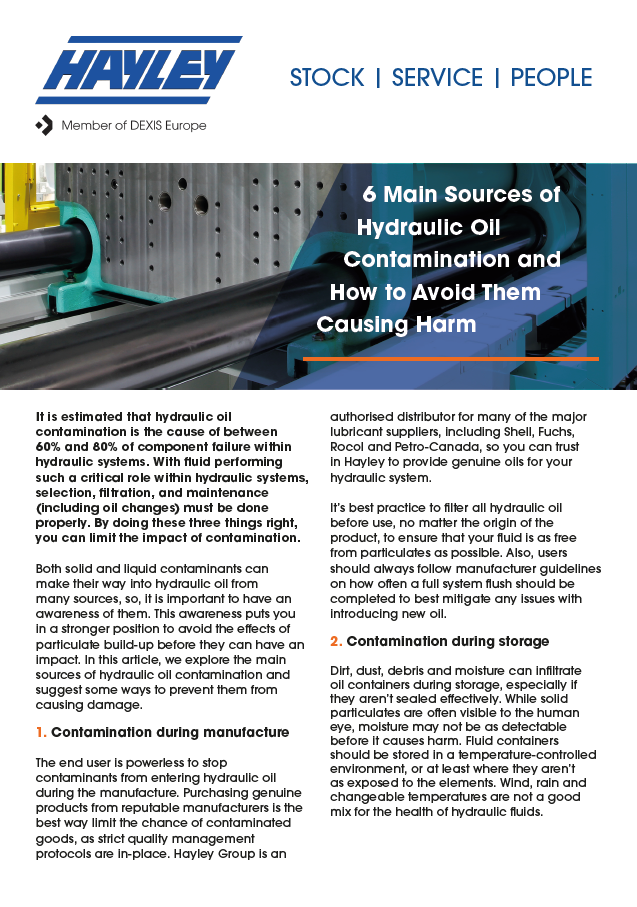It is estimated that hydraulic oil contamination is the cause of between 60% and 80% of component failure within hydraulic systems. With fluid performing such a critical role within hydraulic systems, selection, filtration, and maintenance (including oil changes) must be done properly. By doing these three things right, you can limit the impact of contamination.
Both solid and liquid contaminants can make their way into hydraulic oil from many sources, so, it is important to have an awareness of them. This awareness puts you in a stronger position to avoid the effects of particulate build-up before they can have an impact. In this article, we explore the main sources of hydraulic oil contamination and suggest some ways to prevent them from causing damage.
1. Contamination during manufacture
The end user is powerless to stop contaminants from entering hydraulic oil during the manufacture. Purchasing genuine products from reputable manufacturers is the best way limit the chance of contaminated goods, as strict quality management protocols are in-place. Hayley Group is an authorised distributor for many of the major lubricant suppliers, including Shell, Fuchs, Rocol and Petro-Canada, so you can trust in Hayley to provide genuine oils for your hydraulic system.
It’s best practice to filter all hydraulic oil before use, no matter the origin of the product, to ensure that your fluid is as free from particulates as possible. Also, users should always follow manufacturer guidelines on how often a full system flush should be completed to best mitigate any issues with introducing new oil.
2. Contamination during storage
Dirt, dust, debris and moisture can infiltrate oil containers during storage, especially if they aren’t sealed effectively. While solid particulates are often visible to the human eye, moisture may not be as detectable before it causes harm. Fluid containers should be stored in a temperature controlled environment, or at least where they aren’t as exposed to the elements. Wind, rain and changeable temperatures are not a good mix for the health of hydraulic fluids.
Moisture in hydraulic oil can kickstart a process called “breathing” and is often a result of exposure to variable temperatures and rainfall. To avoid water collecting on the top of containers, those stored outdoors should be lay on their side. A fluid that has been subject to “breathing” can suffer from severely reduced performance capabilities.
3. Contamination during handling/transfer
During the handling and transfer of hydraulic fluid, the fluid should be kept away from contaminants such as dust and moisture. During transfer of the oil from container to system the environment must be clean, tidy and dry. Containers should never be open for longer than absolutely necessary. Components and tools used in the transfer process should also be well cleaned before use.
Fluids should also never be mixed, as this could cause unintentional and potentially damaging chemical reactions within your hydraulic system. To avoid this, a system should always be flushed before new oil is used.
4. Contamination during maintenance
During maintenance, use the same principles of environment and equipment cleanliness before proceeding. Preparation is fundamental to any maintenance activity involving hydraulic systems. By using a lint-free cloth to clean the exterior of components, capping hoses and plug ports, and only removing new seals and filters from their original packaging immediately prior to installation, contamination risk is reduced.
Hydraulic fluid can be exposed to high temperatures during system servicing, and this is also something to be aware of, as contamination can occur due to this too.
5. Contamination over time
Contamination is likely to happen in some form over the course of the service life of a hydraulic fluid, particularly towards the end of this cycle. The service life of components such as bearings or seals also affect this as they degrade over the course of time. For instance, tiny metal/rubber fragments fracture off and are able to escape into the system. Effective filtration will help to stop these contaminants from moving freely around the system.
A rigorous oil testing and analysis programme is the best method of combatting contamination that occurs over time. As an approved fluid care partner of HYDAC, Hayley is able to provide the full suite of laboratory testing services for hydraulic oil users. This offering includes microscopic contamination analysis, particle distribution measurement and water content analysis, all to the associated ISO and ASTM standards.
6. Contamination pre-existing in system
Contaminant particulates can also remain from the manufacturing of the components in the system. Casting sand remaining in a cast part, sealing tape left on a port, and traces of OEM grease can all represent pre-existing contamination.
Tackle this form of contamination by utilising appropriate filtration hardware and by regularly carrying out oil analysis.
Contamination is a concern for all users of hydraulic fluid. By taking the suggestions above into account, you can limit the impact that oil contamination can have on your system(s) and your wider business operation. To enquire about filtration solutions, or the testing and analysis services we’ve mentioned in this article, contact your local Hayley Group branch.



